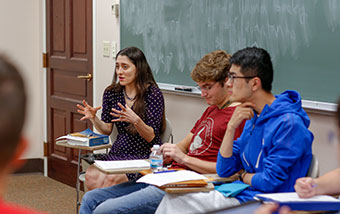When Wabash College was approached about partnering with the American Talent Initiative (ATI) to expand efforts to enroll high-achieving, low-income students, it seemed like a perfect match. Wabash has a historic commitment to helping young men enroll at the College regardless of their financial circumstances.
ATI comprises 128 colleges and universities with high graduation rates (70% or higher), who together have set a goal to enroll 50,000 low-income students by 2025. In its annual report released today, ATI shares remarkable progress: in just three years, colleges and universities have enrolled 20,000 more low- and moderate-income students who receive federal Pell Grants. ATI member schools have contributed disproportionately to this increase.
“When we introduced the Wabash Promise three years ago, we wanted to be completely transparent about our scholarship and financial aid programs, and make it clear to prospective students that a Wabash education is truly affordable, regardless of income levels,” said Dr. Gregory Hess, President of Wabash College. “Wabash’s mission and core values are in alignment with the goals of the American Talent Initiative.”
Under the Wabash Promise, Pell Grant-eligible students from Indiana receive grants to cover the full cost of tuition not covered by government grants, while tuition for students from families earning $125,000 or less is equivalent to the state’s flagship university.
“We wanted to let people know that Wabash is committed to investing in talented young men who seek a challenging, life-changing liberal arts education,” said President Hess.
In the 2019-20 school year, nearly 29 percent of the student body receives federal Pell Grants. The average percentage of Pell-eligible students at the 128 members of the ATI is 23 percent.
According to the ATI Annual Report, successful institutions share a common theme: “Leaders of these institutions prioritize and put resources behind a comprehensive strategy for expanded opportunity. In practice, this means that there is focused attention and a concrete plan for promoting socioeconomic diversity across the whole student experience: robust outreach to prospective students, more inclusive admissions and yield practices, need-based financial aid that supports access and affordability, and intentional practices to ensure equitable student inclusion, belonging, and success.”
Wabash is proud of its innovative Wabash Liberal Arts Immersion Program (WLAIP), a one-month, on-campus summer program for entering freshman students meet two of three criteria: first generation student, student of color, or Pell-eligible student. The College’s first cohort of WLAIP students had a four-year graduation .jpg) rate of 80%, which was slightly higher than the overall student body in the Class of 2019.
rate of 80%, which was slightly higher than the overall student body in the Class of 2019.
“Wabash is committed to providing access to qualified students, and supporting them during their time on campus and throughout their lives,” added President Hess.
ATI, which is supported by Bloomberg Philanthropies and managed by the Aspen Institute College Excellence Program and Ithaka S+R, has grown from 30 founding members in 2016 to 128 by the end of 2019 and includes flagship state universities, prominent liberal arts colleges, and every member of the Ivy League. The initiative is also funded by the Gray Foundation and the Jeffrey H. and Shari L. Aronson Family Foundation.